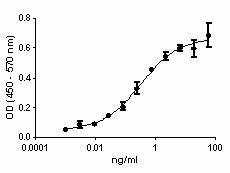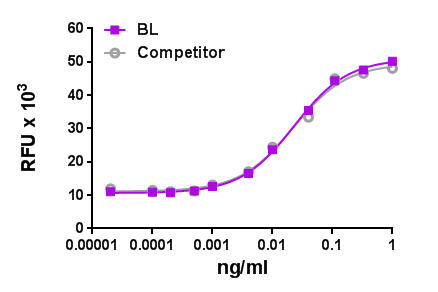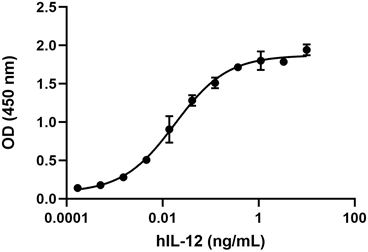- Regulatory Status
- RUO
- Other Names
- alpha subunit p19 and Interleukin-12 subunit beta p40
- Ave. Rating
- Submit a Review
- Product Citations
- publications

-

Human IL-23 induces IL-17A in mouse splenocytes. -

Comparison of mammalian-expressed (cat. no. 787904) and insect-expressed human IL-23 (cat. no. 574104) demonstrates a greater than twofold higher potency for the mammalian-expressed protein as measured by induction of IL-17A production in mouse splenocytes.
Interleukin 23 (IL-23) is a member of the IL-6 family of cytokines, and it is comprised of two subunits, p19 and p40. The p19/p40 heterodimer is stabilized by a disulfide bond. The p40 subunit is shared by IL-23 and IL-12 cytokines. p19 mRNA is expressed in endothelial cells and polarized T cells; p40 is not expressed by these cells. Therefore, the availability of functional IL-23 is limited by the expression of p40 and not p19. IL-23 exerts its biological activities through the interaction with a heterodimeric receptor complex composed of IL-12Rb1 and IL-23R. IL-23 activates Janus kinase (JAK)/signal transducer and activator of transcription (STAT) signaling molecules. JAK2 is constitutively associated with the IL-23R chain, and binding of IL-23 to its receptor leads to phosphorylation of STAT1, STAT3, STAT4, and STAT5.
Product DetailsProduct Details
- Source
- Human IL-23 consists of two subunits linked via a disulfide bond: P19 (Accession# NP_057668: Ala21- Pro189) and P40 (Accession# NP_002178.2: Ile 23-Ser 328). Human IL-23 was expressed in insect cells.
- Molecular Mass
- The total predicted molecular weight is 53.3 Da. The non-reduced protein migrates at approximately 60 kD and the DTT-reduced protein produces two bands at approximately 19 kD and 40 KD by SDS-PAGE.
- Purity
- >95%, as determined by Coomassie stained SDS-PAGE.
- Formulation
- 0.22 µm filtered protein solution is in PBS.
- Endotoxin Level
- Less than 0.01 ng per µg cytokine as determined by the LAL method.
- Concentration
- 10 and 25 µg sizes are bottled at 250 µg/mL. 100 µg size and larger sizes are lot-specific and bottled at the concentration indicated on the vial. To obtain lot-specific concentration and expiration, please enter the lot number in our Certificate of Analysis online tool.
- Storage & Handling
- Unopened vial can be stored between 2°C and 8°C for up to 2 weeks, at -20°C for up to six months, or at -70°C or colder until the expiration date. For maximum results, quick spin vial prior to opening. The protein can be aliquoted and stored at -20°C or colder. Stock solutions can also be prepared at 50 - 100 µg/mL in appropriate sterile buffer, carrier protein such as 0.2 - 1% BSA or HSA can be added when preparing the stock solution. Aliquots can be stored between 2°C and 8°C for up to one week and stored at -20°C or colder for up to 3 months. Avoid repeated freeze/thaw cycles.
- Activity
- ED50=0.4 - 2.0 ng/ml, corresponding to a specific activity of 0.5 - 2.5 x 106 units/mg as determined by mouse splenocyte IL-17A secretion, which is induced by hIL-23 in a dose dependent manner.
- Application
-
Bioassay
- Application Notes
-
Have you considered our mammalian-expressed human IL-23? It has >twofold higher potency and is offered at a better value. See our recommended products: Recombinant Human IL-23 (mammalian expressed, carrier-free) or discuss with our technical experts.
BioLegend carrier-free recombinant proteins provided in liquid format are shipped on blue-ice. Our comparison testing data indicates that when handled and stored as recommended, the liquid format has equal or better stability and shelf-life compared to commercially available lyophilized proteins after reconstitution. Our liquid proteins are verified in-house to maintain activity after shipping on blue ice and are backed by our 100% satisfaction guarantee. If you have any concerns, contact us at tech@biolegend.com. - Product Citations
-
Antigen Details
- Structure
- Heterodimer
- Distribution
-
IL-23 is highly expressed by activated dendritic cells, macrophages, and epidermal Langerhans cells.
- Function
- IL-23 promotes Th17 responses in vivo, and it is important for the survival and population expansion of Th17 cells. IL-23 induces proliferation of memory T cells and the induction of IL-17A and IL-17F in these cells. In conjunction with IL-1, IL-23 is sufficient to induce naïve human T cells to produce IL-17A, IL-17F, IL-22, IL-26, IFN-γ, CCL20/MIP-3α, and the transcription factor RORγt. PGE2 favors the production of IL-23 and inhibit IL-12 in dendritic cells. PGE2 synergizes with IL-23 in expanding Th17 cells from purified memory CD4+ T cells activated in the absence of accessory cells. IL-23 induces IFN-gamma production from T cells treated with PHA. In addition, IL-23 plays a key role in the pathogenesis of autoimmune and chronic inflammatory disorders. This role is supported by the identification of IL-23 receptor (IL-23R) susceptibility alleles associated with inflammatory bowel disease, psoriasis, and ankylosing spondylitis.
- Interaction
- Memory T cells, Inflammatory macrophages, NK cells, dendritic cells, and monocytes.
- Ligand/Receptor
- IL-23 binds to L-12Rb1 and IL-23R
- Biology Area
- Immunology, Stem Cells
- Molecular Family
- Cytokines/Chemokines
- Antigen References
-
1. Oppmann B, et al. 2000. Immunity 13:715.
2. Aggarwal S, et al. 2003. J. Biol. Chem. 278:1910.
3. Piskin G, et al. 2006. J. Immunol. 176:1908.
4. McGeachy MJ, et al. 2007. Nat. Immunol. 8:1390.
5. Wilson NJ, et al. 2007. Nat. Immunol. 8:950.
6. Bonifac B, et al. 2008. Immunol. Rev. 226:132.
7. Chizzolini C, et al. 2008. Blood 112:3696.
8. Buonocore S, et al. 2010. Nature 464:1371. - Gene ID
- 3593 View all products for this Gene ID 51561 View all products for this Gene ID
- Specificity (DOES NOT SHOW ON TDS):
- IL-23
- Specificity Alt (DOES NOT SHOW ON TDS):
- IL-23
- App Abbreviation (DOES NOT SHOW ON TDS):
- BA
- UniProt
- View information about IL-23 on UniProt.org
Related FAQs
- Why choose BioLegend recombinant proteins?
-
• Each lot of product is quality-tested for bioactivity as indicated on the data sheet.
• Greater than 95% Purity or higher, tested on every lot of product.
• 100% Satisfaction Guarantee for quality performance, stability, and consistency.
• Ready-to-use liquid format saves time and reduces challenges associated with reconstitution.
• Bulk and customization available. Contact us.
• Learn more about our Recombinant Proteins. - How does the activity of your recombinant proteins compare to competitors?
-
We quality control each and every lot of recombinant protein. Not only do we check its bioactivity, but we also compare it against other commercially available recombinant proteins. We make sure each recombinant protein’s activity is at least as good as or better than the competition’s. In order to provide you with the best possible product, we ensure that our testing process is rigorous and thorough. If you’re curious and eager to make the switch to BioLegend recombinants, contact your sales representative today!
- What is the specific activity or ED50 of my recombinant protein?
-
The specific activity range of the protein is indicated on the product datasheets. Because the exact activity values on a per unit basis can largely fluctuate depending on a number of factors, including the nature of the assay, cell density, age of cells/passage number, culture media used, and end user technique, the specific activity is best defined as a range and we guarantee the specific activity of all our lots will be within the range indicated on the datasheet. Please note this only applies to recombinants labeled for use in bioassays. ELISA standard recombinant proteins are not recommended for bioassay usage as they are not tested for these applications.
- Have your recombinants been tested for stability?
-
Our testing shows that the recombinant proteins are able to withstand room temperature for a week without losing activity. In addition the recombinant proteins were also found to withstand four cycles of freeze and thaw without losing activity.
- Does specific activity of a recombinant protein vary between lots?
-
Specific activity will vary for each lot and for the type of experiment that is done to validate it, but all passed lots will have activity within the established ED50 range for the product and we guarantee that our products will have lot-to-lot consistency. Please conduct an experiment-specific validation to find the optimal ED50 for your system.
- How do you convert activity as an ED50 in ng/ml to a specific activity in Units/mg?
-
Use formula Specific activity (Units/mg) = 10^6/ ED50 (ng/mL)

 Login / Register
Login / Register 













Follow Us